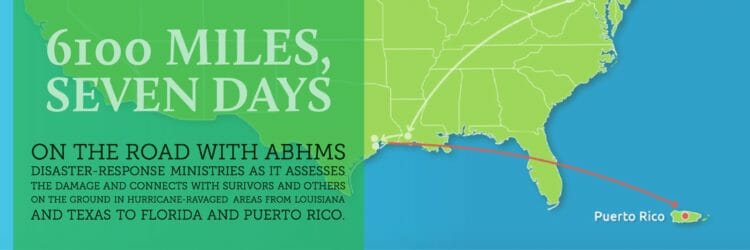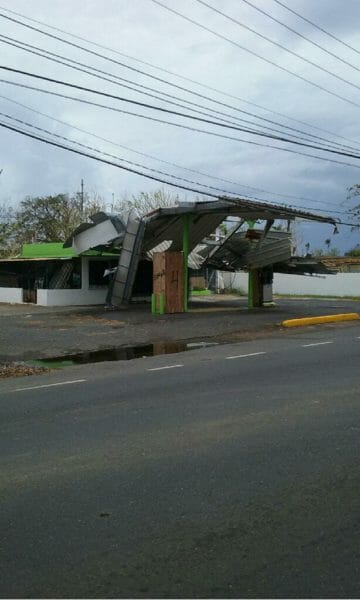6,100 miles, seven days: In the wake of Maria’s sound and fury

Day five: Not that I know what a war zone looks like, but, in my mind’s eye, I see it as Puerto Rico, one week after Hurricane Maria.
 When we arrived Friday morning, the airport felt like a ghost town: Most of the restaurants and food vendors, as well as souvenir and newsstands, were shuttered tight. Large fans, a poor substitute for air conditioning, stood guard at the arrival gate. In the department of little-things-we-take-for-granted, a man struggling with a suitcase and carry-on bag as he descended the stairs in front of me affirmed the value of escalators. From now on, I will always give thanks for working escalators in airports.
When we arrived Friday morning, the airport felt like a ghost town: Most of the restaurants and food vendors, as well as souvenir and newsstands, were shuttered tight. Large fans, a poor substitute for air conditioning, stood guard at the arrival gate. In the department of little-things-we-take-for-granted, a man struggling with a suitcase and carry-on bag as he descended the stairs in front of me affirmed the value of escalators. From now on, I will always give thanks for working escalators in airports.
Outside the airport, tall, defrocked palm trees sported just a few spindly brownish fronds. Groves of trees, gray and stripped of foliage, stood harsh and naked against the day’s beautiful blue sky, foreshadowing the scenes that followed as we drove to Iglesia Bautista Church of Rio Piedras.
Everywhere mangled buildings, uprooted trees—lying sideways as though tossed around like toothpicks—and piles of branches, roots and debris blocking roads told the story of Maria’s wrath and power. A city park in Old San Juan looked like a wasteland.
There’s no electricity. No working elevators in hotels to transport luggage to a fifth floor room. No hot showers. No lights, so nights in San Juan are very, very dark. And no working outlets to charge a phone or a laptop. Yes, some people have generators, but finding gasoline to run them is a challenge.
In San Juan, most hotels and restaurants are closed. The restaurant where I ate breakfast had a limited menu and took no credit cards. Only cash was acceptable payment, and exact change, to boot, because banks are closed. There is no money.
There are long lines for ice. I saw blocks-long lines of cars waiting at gas stations. And lines of people, double-digits-deep, waiting to fill up gas cans to run generators. There are more lines at ATM machines. With no traffic lights, intersections in San Juan require courage, fortitude and patience.
That’s just what I saw. I heard the wait for gas can range from four to eight hours. I heard that in some areas of the island residents are allowed only one gallon of water per person per day. I heard concerns about people who live in the central, mountainous part of the island. There, bridges have been destroyed and roads have been washed away. There’s no telling what destruction Maria left behind here; no one can get in, or out. People who live in these areas have no water and no food.
Hurricane Maria rendered Puerto Rico a Third World country.
By the time I left Puerto Rico, after just one day, I had tears in my eyes. What’s happening there is a humanitarian crisis of epic proportions, multi-layered and complex, which calls out with great urgency for help from American Baptists, the United States and the rest of the world.
In the next blog, find out how American Baptist Home Mission Societies is reaching out to touch the people of Puerto Rico.
Part four of a multiple part series as American Baptist Home Mission Societies (ABHMS) takes American Baptists on the road with ABHMS Disaster-response Ministries as it assesses the damage and connects with survivors and others on the ground in hurricane-ravaged areas from Louisiana and Texas to Florida and Puerto Rico.
Susan Gottshall is American Baptist Home Mission Societies Associate Executive Director, Communications.

